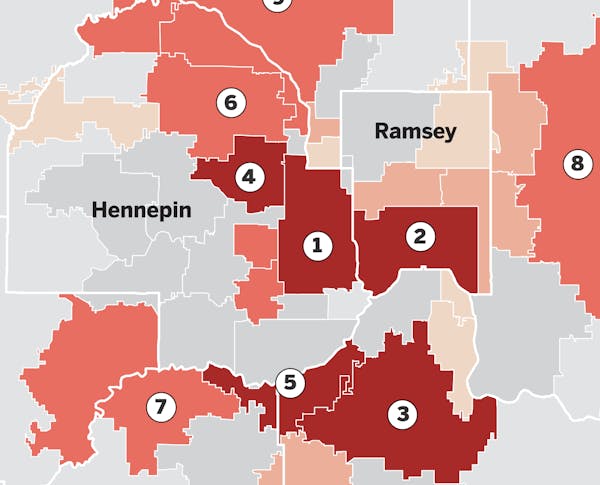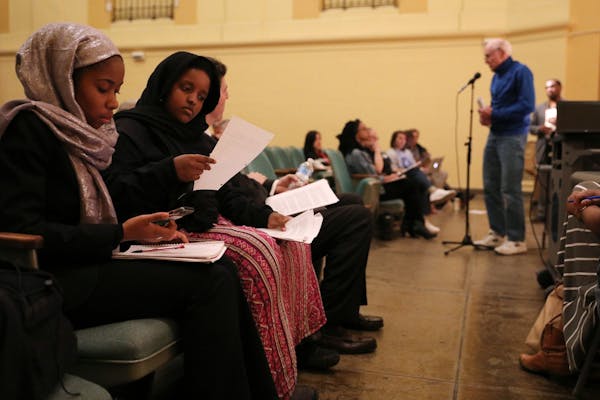Metro-area school districts are facing one of the worst budget-cutting seasons in recent years, and they plan to lay off more than 240 teachers and other staff to save money.
In the metro area, 26 school districts are confronting a total shortfall of more than $108 million for the 2018-2019 school year — the highest amount since 2011, according to a recent survey by the Association of Metropolitan School Districts.
Because staffing makes up a large portion of budgets, districts are relying on job cuts to balance their budgets.
"It's the largest we've seen in a few years," said Scott Croonquist, the group's executive director. "It's more districts, and more districts facing larger shortfalls than we've seen in a time."
In Robbinsdale, a $10.6 million shortfall means 73 positions are up for possible cuts. In Monticello, 25 positions are on the line to close a $2 million deficit. And in Burnsville, 40 jobs are on the cutting board to sew up a $6.7 million budget gap.
The numbers are still moving targets, with districts revising budgets before June 30 deadlines for final approval. But all districts blame insufficient state aid for not keeping pace with the rising costs of special education and English-learner programs.
"We just have this gap that keeps on growing," said Lisa Rider, the Burnsville-Eagan-Savage School District's executive director of business services. "That's a challenge for schools across the state."
Gov. Mark Dayton has proposed boosting special education funding by about $19 million for 2019, but several school districts say it won't eradicate the need for significant budget cuts.
In Minneapolis, 350 to 400 positions could be eliminated amid a whopping $33 million deficit, while the St. Paul district faces a $17.2 million deficit. But the urban districts aren't alone.
Closing the gap
Like Minneapolis, the Burnsville-Eagan-Savage district has declining enrollment and has tapped its reserves over the years, but says it can't continue to do so.
This year, the district has 8,590 students, down from 9,341 in 2013-2014 thanks to an aging population in south metro suburbs and students enrolling in schools in neighboring districts. State funding has increased 2 percent, while expenses are going up 3.5 percent.
"We tried hard in this process to stay away from our core classroom and support needs," Rider said. "It's difficult because, no matter what, it impacts someone in our community."
To close its $6.7 million gap, in addition to drawing down reserves the district is slashing $4.4 million in expenses by reducing 22 licensed and 18 nonlicensed staff positions as well as trimming spending on travel, printing and activities.
"This seems to be one of the larger amounts [of cuts]," said Wendy Drugge, a math teacher who's taught in the district for 16 years and leads the Burnsville teachers' union, which picketed this week after 300 days without a contract. "The teachers are hoping whatever cuts are made are kept at a minimum."
Burnsville district officials say it could have been worse if voters last fall hadn't approved increasing the operating levy, providing $3.9 million each year. Without it, budget cuts would have totaled $12 million, district officials say.
'Drastic' cuts
Not every district is issuing pink slips to solve budget woes. For instance, the Rosemount-Apple Valley-Eagan district has a $12 million deficit and is drawing from reserves, not cutting staff.
Robbinsdale, the state's ninth largest district, faces a $10.6 million shortfall, and School Board Chairman John Vento said not making cuts isn't an option. Proposed cuts call for losing 38 licensed positions and 35 nonlicensed positions.
"It's difficult; we're trying to do the best for all of our students … and live within our means," Vento said. "We're making a concerted effort not to cut the front-line teachers."
The deficit is the largest in his five years with the 12,500-student district, he said, and is due to dropping enrollment, increasing teacher pay and rising special education and English-learner costs.
"We're looking at every line item from the superintendent's office on down," Superintendent Carlton Jenkins said.
In Monticello, with 4,200 students northwest of the Twin Cities, the district has a $2 million deficit and is reducing 25 licensed and nonlicensed staff positions.
That's the deepest cut Joe Rosh, a high school history teacher and leader of the teacher union, has seen in his 11 years there.
"This time it's very drastic for a school district like us," he said, adding that teacher cuts will increase class sizes and give teachers less time to work with individual students. "This is going to change the world we teach in."
Monticello's Interim Superintendent Michael Favor said the district is getting hit hard by special education costs and district leaders have appealed — so far, unsuccessfully — to legislators for help.
"Right now, the best way to come into alignment is to reduce staff," Favor said. "We can't operate in a deficit."
Kelly Smith • 612-673-4141
Her son bought a fake pill via Snapchat. Fentanyl killed him. Now, Hastings mom is on a mission.

St. Paul event organizers aim for spirit of Midwest Mountaineering expos
Rosemount-Apple Valley-Eagan school district selects new superintendent

8 Twin Cities area grocery stores, ranked by affordability


